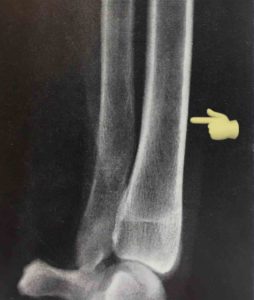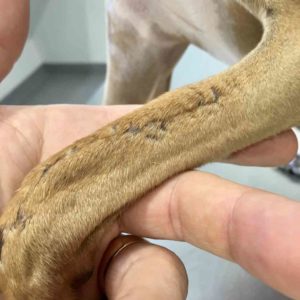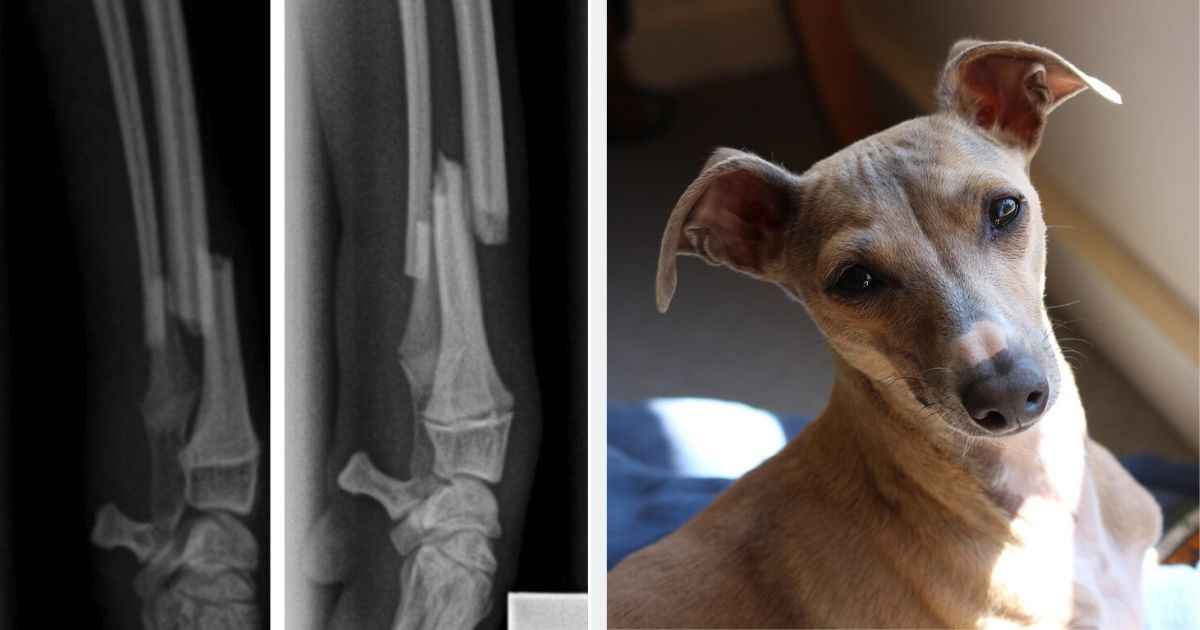Updated November 28, 2020
Dante is an all-too-familiar story. I saw him recently for vaccination and immediately noticed the scar on his leg. What happened? He was running and broke his leg.
If this happens to your dog, here’s a quick first aid tip: carefully put the lower leg into a roughly normal position, wrap it in a t-shirt until it’s a thick roll and then sticky tape it. If you can’t do this, just keep your dog as quiet as possible. This will stop possible damage to soft tissues caused by excessive motion across the fracture site. Then go straight to a vet.
Leg fractures in Italian Greyhounds are common. If you’re looking to buy a puppy, or take out insurance you might well ask, “yes, but how common?” The answer may affect what you do next.
Frequency Of Leg Breaks
I went though our files and looked at the Italian Greyhounds we’ve known. There are 7 fractures in around 30 dogs, although many files only cover part of a dog’s life.
Applying a very rough and ready adjustment for how long we knew each dog, it looks like the rate of fracture is between 25 and 45% of Italian Greyhounds. That is, less than half, but possibly not by much.
It’s also important to know that two of those dogs broke both forelimbs at different times. Strange, isn’t it?
Why Italian Greyhounds Break Legs
The break for which this beed is famous is in the lower forelimb just above the wrist. We call this a fracture of the distal radius and ulna. It mostly happens as puppy or young adult, but we’ve also seen it in an eight-year old.

Pictured here for comparison is the lower foreleg of a medium-sized dog breed. The pointer shows the outer (white) layer of the radius called the cortex. Inside it is the medullary cavity containing a fine latticework of trabecular bone.
Now look back at the pictures of Italian Greyhound broken legs at the start. What you’ll notice are three things:
- The cortex is comparatively thick
- The medullary cavity is very narrow
- The overall width of the bone is reduced
All three factors are likely to decrease bone strength.
Prevention of Broken Legs

These changes are almost certainly inherited traits. So the first thing you can do is try to avoid lines with known issues. You’re unlikely to be able to find this out, but if you see a scar or swelling on a forelimb like the picture, that would be a good clue.
Before I go on, let me say that it’s not only a problem of Italian Greyhounds. Toy Poodles, Chihuahuas, Yorkshire Terriers and some other toy breeds also suffer the same fate, although it seems less common.
What I don’t believe you can do is restrict exercise enough to stop it happening. I would certainly advise you to avoid running play, or jumping from furniture, but most dogs seem to do it just running in the house like any other dog. That’s what happened to Dante, despite his owners already trying their best.
Some of the advice seems to just be making dog owners anxious without really changing the outcome. To some extent, if you have this breed you need to have accepted the risk and already thought about what you would do.
Being Prepared
The first thing vets would ask anyone getting any dog is to be ready for the unexpected. Repairing these fractures requires the placement of a compression plate or external fixator, usually by a specialist surgeon. In Australia this might cost around $4000. As common as it is in Italian Greyhounds, it can happen to any dog.
Too often, breeds that are expensive to maintain end up being surrendered when things go wrong. Other examples are Shar Peis and French Bulldogs. None of this should happen with decent insurance or savings.
So don’t let the risk stop you getting an ‘Iggie’. They are a lot more than just their legs: adorable, affectionate, intelligent, fun. Not one of these owners who were prepared ever regretted their choice.
Related: The costs of insuring different dog breeds. You’ll see that some are much higher than others, which gives you an idea of health care costs.
Have something to add? Comments (if open) will appear within 24 hours.
By Andrew Spanner BVSc(Hons) MVetStud, a vet in Adelaide, Australia. Meet his team here.


What should be included for a balanced and appropriate diet for a 12 month old Italian Greyhound which has already had 2 fractures to forelimbs?
Hi Zoe. There’s probably no influence of the diet above buying any high-quality balanced food. In fact, addition of nutrients such as calcium could be negative above normal requirements. Additionally, if both forelimbs have already been plated, there’s not much chance of it happening again.
If you’re considering getting one of these dogs, don’t. My sister has had two and paid out about $15,000 in broken legs so far (two breaks, two dogs, one complication that required a second surgery) They are a disaster waiting to happen. A high energy dog with little bird bones and bad judgment.
I’m sorry to say I feel this way as well. My fiancés dog is an Italian greyhound and so I can’t help but love her but I know when the time comes and we are looking at getting our next dog I will not be interesse din taking on the risk. He’s had two Italian greyhounds. One broke both her front legs as a puppy and the one we have now broke one leg as a puppy and rebrote the same leg as an adult (15 years old). We spent $3,500 on this last surgery it’s a hard pill to swallow. But we will find a dog that’s e love taht isn’t an accident waiting to happen. She truly does have bad judgment. She chose to jump onto a high counter and when I saw her instead of staying up there until I got her down she freaked (because she knew she wasn’t meant to be up there looking for food) and bam $3500 bill and so much suffering on herself and all of us. Especially my fiancé who I now know does not ah for emergencies as well as I expected.
Does giving a calcium supplement as a puppy help?
Hi Linda. Almost certainly, it will actually increase the risk over using a balanced diet.